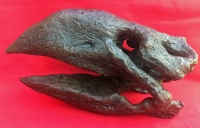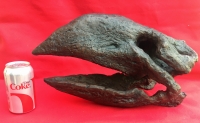
Gastornis is an extinct genus of large flightless birds that lived during the late Paleocene and Eocene epochs of the Cenozoic era 56-45 million years ago. The genus is currently thought to contain three or four distinct species, known from incomplete fossil remains, found in western-central Europe (England, Belgium, France, and Germany). More complete specimens are known from a fourth, North American species.
Gastornis species were exceptionally large birds, and have traditionally been considered to be predators of small mammals. However, several lines of evidence, including the lack of hooked claws in known Gastornis footprints and studies of their beak structure have caused scientists to reinterpret these birds as herbivores that probably fed on tough plant material and seeds.
Gastornis is known from a large amount of fossil remains, but the clearest picture of the bird comes from a few nearly complete specimens of the species G. gigantea. These were generally exceptionally large birds, with huge beaks and massive skulls superficially similar to the carnivorous South American "terror birds" (phorusrhacids). The largest known species, G. gigantea could grow to the size of the largest moas, and reached about 2 m (6 ft 7 in) in maximum height and weigh perhaps 200 pounds.
The skull of G. gigantea was huge compared to the body and powerfully built. The beak was extremely tall and compressed (flattened from side to side). Unlike other species of Gastornis, G. gigantea lacked characteristic grooves and pits on the underlying bone. The 'lip' of the beak was straight, without a raptorial hook as found in the predatory phorusrhacids. The nostrils were small and positioned close to the front of the eyes about midway up the skull. The vertebrae were short and massive, even in the neck. The neck was relatively short, consisting of at least 13 massive vertebrae. The torso was relatively short. The wings were vestigial, with the upper wing-bones small and highly reduced, similar in proportion to the wings of the cassowary.
The plumage of Gastornis has since been identified, from the Green River Formation. Unlike filamentous plant material, this single isolated feather resembles the body feathers of flighted birds, being broad and veined. It was tentatively identified as a possible Gastornis feather based on its size; the feather measured 240 mm (9.4 in) long and must have belonged to a gigantic bird.
resin
16 x 7.5 x 9.5 inches
Item 3661
Category: Replicas
Type: Skulls
Phylum: Vertebrates
Class: Birds
MORE PHOTOS:




Now Over 1,000 Items!
PrehistoricStore.com offers the largest selection of replica fossils and other fossil-related products anywhere in the world!
Download a Full Catalog (3MB PDF)
OVER 260 PAGES OF REPLICAS AND MORE!
